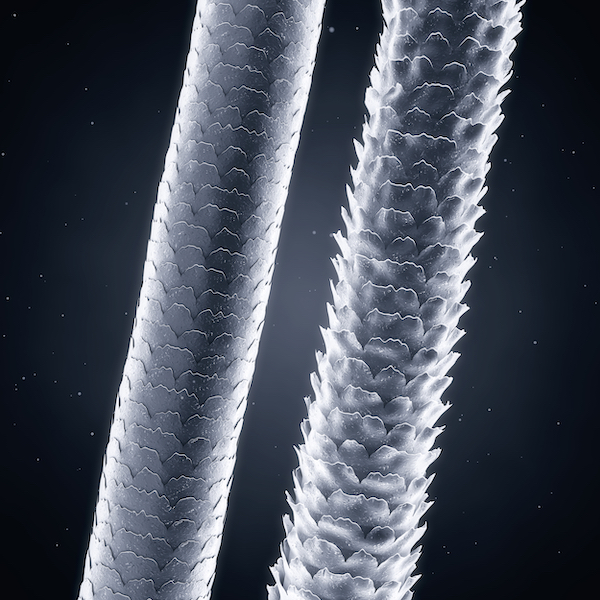
Hair Breakage, Hair Loss, and Hair Repair
Healthy hair is a reflection of a healthy scalp, balanced care, and protective practices. But if you’re noticing more strands in the shower drain, dry, brittle hair, or split ends that won’t go away, you’re not alone. Hair breakage and hair loss are common concerns, and while they are different issues, they often appear together and may share overlapping causes. The good news is, hair can be supported and repaired with the right knowledge and ingredients.
Understanding Hair Breakage vs. Hair Loss
Hair breakage is when the hair shaft becomes weak and snaps off, often from the mid-length to the ends. This is usually caused by damage from heat, chemicals, friction, or lack of moisture.
Hair loss, on the other hand, happens at the root. It may be due to stress, hormone imbalance, medical conditions, nutritional deficiencies, or genetics. While breakage affects the strand itself, loss affects the follicle.
Both issues can result in thinning hair, less volume, and shorter hair that seems like it never grows.
Damaged Hair: What It Looks Like
Damaged hair isn’t always obvious right away. But under closer observation, or through touch, it becomes clear.
When hair is damaged:
-
The outer layer (cuticle) is no longer smooth; it becomes rough and serrated
-
Hair loses its natural shine
-
It tangles easily and feels coarse
-
The strand is unable to hold onto moisture, resulting in dry hair
-
Products can easily penetrate the weakened strand, sometimes leading to buildup or further fragility
Hair Repair: Can You Truly Fix Damaged Hair?
Hair repair means improving the condition and appearance of damaged strands. Once the cuticle layer lifts and the strand breaks down, it can’t be restored to its original undamaged state. However, it can be repaired.
Think of sealing a crack on a pottery dish, it fixes the flaw, but the dish isn’t quite like new. Hair repair works in a similar way by smoothing rough cuticles and reinforcing weakened areas to prevent further damage.
Hydrolyzed Proteins: A Key to Hair Repair
One of the best ingredients for hair repair is hydrolyzed protein. These proteins are broken down into smaller fragments, making them able to either penetrate or coat the hair strand, depending on their molecular weight.
-
Low molecular weight proteins can enter the hair shaft, strengthening it from within.
-
High molecular weight proteins sit on the surface, smoothing the cuticle and enhancing shine.
Hydrolyzed proteins work exceptionally well on damaged hair and split ends. They’re compatible with most ingredients and can be incorporated into shampoos, conditioners, masks, serums, and leave-in treatments.
If you’re an alumni cosmetic formulator in the Pro Natural Hair Course, refer to Module 2: Hair Porosity and Module 4: Proteins for detailed guidance on selecting and using proteins in your formulations.
Split Ends: Treating and Preventing Them
Split ends happen when the protective outer layer of the hair is worn away, allowing the strand to fray or split in two. While there is no true way to fuse split ends back together permanently, you can temporarily smooth and protect them.
What you can do:
-
Apply a small amount of oil, serum, or conditioner (leave-in) to the ends to reduce friction and seal the strand
-
Use formulations with hydrolyzed proteins for ongoing protection and smoothing
-
The best solution? Regular trims to remove the split ends before they travel up the strand
Tips to Prevent Hair Breakage and Support Repair
-
Avoid excessive heat styling (hair dryers, heat appliances) always use a heat protectant, diffuser and low heat
-
Choose gentle, sulfate-free shampoos and moisturizing conditioners
- Cocktail styling agents, a light serum + a light leave-in + hair bonding oil
-
Sleep on a satin pillowcase to reduce friction
-
Don’t brush wet hair aggressively, use a wide-tooth comb
-
Deep condition weekly, especially for chemically processed or curly hair
-
Include hydrolyzed proteins in your routine for fortification
Hair Repair is Possible
Hair repair is possible. With the right shampoo, conditioner, treatments, and styling products and hair care practices, you can smooth the surface of the hair, reduce breakage, and prevent split ends from worsening. Whether you’re formulating professional products or seeking ways to restore your hair at home, knowledge is your most powerful tool.
Learn about types of Styling Products you can make in this Hair Styling Products Guide Post.
You might also like

